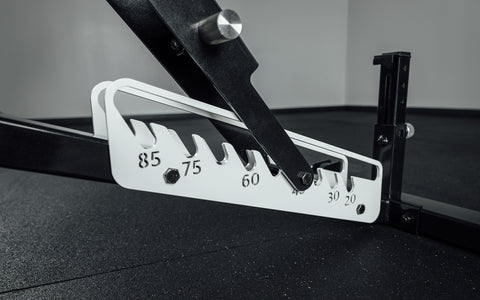
Here’s how the AB-5200 2.0 stands up against the original AB-5200, as well as other top-of-the-line adjustable benches.
The toughest just got tougher – and a lot more personal, too.
The AB-5200 has long deserved its reputation as having incredible value for lifters who want one of the best adjustable benches on the market.
Then the 2.0 version came along.
The AB-5200 2.0 is more than just a few neat improvements to an already top-of-the-line bench. These upgrades pack a ton more versatility and options -- with the goal of making it possible (and easy) for you to design your own perfect adjustable bench for your dream home gym.
Here’s how the AB-5200 2.0 does it.
Original AB-5200 vs. AB-5200 2.0

Both versions of the AB-5200 are adjustable with options to be flat or incline. They are both designed for vertical storage to save space in your gym, and they have a similar horizontal handle that makes it easy to move them around.
And they both have a closed ladder design. A ladder is a fast and simple way to adjust the bench angle with no pop-pin, and a closed ladder keeps everything securely in place when you adjust the angle. It also prevents the ladder from lifting out when it's stored vertically.
Where the AB-5200 and AB-5200 2.0 Differ
But there are plenty of differences between the OG version and the new kid on the block
Decline Capabilities: The most obvious difference is that the original AB-5200 doesn't decline. If you select the adjustable post for the 2.0, you add a decline option down to -8 degrees. (If you choose the fixed post option for the 2.0, you can't decline.)
Weight: The 2.0 is just as sturdy, but it weighs less, making it easier to move around your gym. The AB-5200 weighs 125lbs and the AB-5200 2.0 weighs 115lbs.
Vertical Storage: The 2.0 was carefully designed to better protect the bench and pad. While both benches can be stored vertically, the 2.0 features a protective, plastic liner on its improved, metal stand.

The AB-5200 stored vertically.
Angle Adjustments: The original AB-5200 is a flat-incline adjustable bench with seven back pad angles (0, 15, 30, 45, 60, 75, 85 degrees) and three seat pad angles (0, 15, 30 degrees).

The AB-5200 2.0
The AB-5200 2.0, as a flat-incline bench with the fixed post, has 10 back pad angles (0, 20, 30, 37.5, 45, 52.5, 60, 67.5, 75, 85 degrees) and four seat pad options (0, 8, 20, 30 degrees). When you select the adjustable post to give the AB-5200 2.0 decline capabilities, you add three more back pad angles (-8, -6, -4), bringing the total of back pad angles to 13.
That’s nearly twice as many back pad options.
In addition to more angle options, some of the angles themselves are different. For example, whereas the original bench had a 15-degree seat and back pad option, the new bench has 20 degrees. Due to more angle options, the new bench has smaller jumps, too. For example, instead of jumping straight from 30 to 45 degrees, now you can choose an in between at 37.5. Ultimately, these options allow you to hit muscles in even more ways with more specific, smaller jumps, if desired.
The top back and seat pad angles remain the same, at a standard 85 degrees and 30 degrees, respectively.
Pad Gap: The original AB-5200 had a small pad gap (the space between the back and seat pads) to begin with at 2”, but we made it even smaller at 1.36”.
Updated Front Foot: The new front foot has a flat profile so it doesn't get in the way during use, while increasing the overall stability of the bench.
Increased Stability: The addition of the new, molded front foot liner combined with an improved rear foot and tighter hinge tolerances makes a much more stable bench that feels rock solid in every position.
IPF Standard Height: International Powerlifting Federation regulations specify a height of a bench must fall within about 16.5-17.7” (including the pad). The AB-5200 2.0 has a height of 17.5”, so competitive lifters can optimally train for a meet. This also helps all lifters get good leg drive. The original bench was 18” high, making it slightly outside of IPF specs.
Attention to Detail: The AB-5200 2.0 has a ton of extra details that elevate it, such as: a laser-cut REP logo on the back ladder and front guide rails; a protective liner on the bottom of the front foot with the word “REP;” stainless-steel handles for a clean look; black hardware; and a laser-cut mountain logo on the front ladder.
Customization: The 2.0 is packed with even more ways to customize it. Here are three new ways to make this bench your own.
- The original bench came with standard pads, and if you wanted wide pads, you had to order them separately. The 2.0 allows you to select standard or wide pads from the beginning. No extra steps or purchases.
- The original had four different color options (one color per bench): matte black, metallic black, red, and blue. The 2.0 has six color options: the same four, plus white or army green. And if you want, you can select two different colors for your bench: one for the frame and an accent color on the guide rails. Mix and match colors to fit your style.
-
The original AB-5200 had one support post and it was in a fixed position. But with the 2.0, you can pick a fixed support post or an adjustable post, which allows for decline positions.
Whichever bench you pick, they're both top-of-the-line adjustable benches. Really, the decision comes down to which features you prioritize highest.

NEWSLETTER SIGNUP
Product launch information, promotions, blogs, and REP news.







